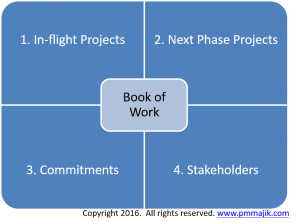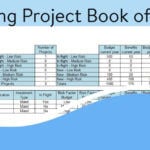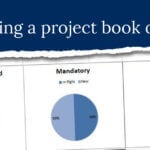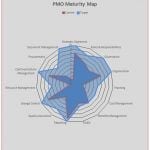In the last post, Overview of a Project Book of Work (BoW), it covered what is a BoW, why you need one and the important data items that need to be captured. This information allows a template to be designed to capture the projects.
This is the second post in the series and will cover what you need to do to identify and capture the projects that will form the BoW.
 1. In-flight Projects
1. In-flight Projects
The first source for building the Project BoW is all of the current in-flight projects. In-flight is the term often used to describe active projects. The fact that they are active should mean that they are important to merit the budget and resources.
When capturing the current projects, it is important to consider what is the criteria of the BoW. For example, if you are building a BoW for the next year, you only should capture the details of those projects that will still be active in the following year.
Tip: When you review the active projects, you may eliminate all of those scheduled to finish in the current year. Before you do this you may want to consider if they will actually finish or will there be delays that mean they need to roll into the following year.
It is advisable to allow some budget for all projects that are due to finish in Q4 just in case they overrun. Additionally look at the performance of the active projects. If there are projects that constantly miss dates and extend the schedule, you need to think hard for including them in the BoW.
2. Next Phase Projects
In some cases, a current in-flight project maybe the pilot / proof of concept for a much bigger project. For example proving a platform is fit for purpose in a single country before embarking on a project for a global roll-out.
So a review needs to take place of all in-flight projects to identify any that will naturally lead to a new project (or continuation of the existing project as a new phase). This applies even to the projects not finishing until following year.
3. Commitments
It is usual for there to be a level of mandatory change that needs to be delivered within an organisation.
It may be that a vendor is remove support for an older version of their software and, to continue to receive support, the software must be upgraded. Regulators may mandate that an organisation makes changes to address weaknesses. Central bodies may change their protocols. An example being the SWIFT payments network who sets a deadline when certain message types must be updated if you wish to continue to use them.
So a “Commitment” should be seen as any change that must be made. These need to be included on the BoW.
4. Stakeholders
When you have constructed the initial BoW you should then engage and hold meetings with key stakeholders. This will allow you to show them the draft BoW so that they can provide feedback on the items captured and help identify additional items that should be included.
It is important to have an initial draft as, starting from a blank piece of paper can appear daunting. It is also likely that seeing a list of projects will make them think of other items that need to be considered. For example if there is a project that is to implement an operational platform to support a new service, this may prompt the stakeholder to consider that a client facing interface and app is required to feed the operational platform.
As part of the process you need to ensure you engage all relevant stakeholders. So make sure you create a stakeholder list and then schedule sessions. You may even want to try and hold a single session. If you have the list, you can check with each stakeholder as you meet them if anyone else should be engaged.
Review
When you have captured all the items and held the stakeholder sessions, you should review the feedback to ensure it makes sense and that there is no duplication. This updated BoW should then be sent out to all of the stakeholders for final review and sign-off.
This should result in a final BoW.
Summary
The process to capture items for a project BoW is achieved through simple, structured actions. It is important to create an initial draft based on solid inputs.
Stakeholder reviews are critical to test the projects that have been captured and identify any that should be added.
Using a final review by all stakeholders should result in an agreed project book of work.
Capture Projects for Book of Work Presentation







